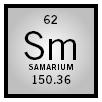Samarium

MELTING POINT:
1,072°C
BOILING POINT:
1,900°C
DENSITY:
7.536 g/cm
3
MOST COMMON IONS:
Sm
2+
, Sm
3+
In 1886, French chemist P. E. Lecoq de Boisbaudran, working with the mixture of oxides known as didymia, isolated the element gadolinium and, three years later, a mixture known as samaria. Working with this mixture, Eugene-Anatole Demarçay (1901) discovered the elements europium and samarium (getting its name from the mineral samarskite). The element comprises 6.47 × 10 −4 percent of the igneous rocks of Earth's crust. The important minerals are bastnasite (in which are found fluorocarbonates of the cerium group), and monazite and xenotime (in which are found phosphates of the cerium and yttrium group, respectively). Two crystal structures exist: α -Sm (at room temperature to 917°C) and β -Sm (at >917°C, body-centered cubic).
The chemistry of samarium(III) is essentially that of all the lanthanide (III) ions. Sm(III) can be reduced to Sm(II) under special conditions, but in solution it is rapidly oxidized to the +3 state. With respect to the solid state, the halides (SmX 2 ) and some chalogenides(II) (oxide, sulfide, selenide, and telluride compounds) have been obtained. SmF 3 , together with the oxide, hydroxide, carbonate, oxalate, and phosphate compounds are insoluble in aqueous solution . The halide, perchlorate, nitrate, and acetate compounds are water-soluble.
The commercially important samarium-containing minerals are treated with concentrated sulfuric acid or, in the case of monazite, with a solution of sodium hydroxide (73%) at approximately 40°C (104°F) and under pressure. The element is separated from the solutions via solvent extraction or ion exchange. Sm 3+ salts are weakly yellow and may exhibit ion emission. Sm 2+ ions show luminescence and are sometimes used to generate lasers. Samarium is used in the manufacture of headphones and tape drivers.
SEE ALSO Cerium ; Dysprosium ; Erbium ; Europium ; Gadolinium ; Holmium ; Lanthanum ; Lutetium ; Neodymium ; Praseodymium ; Promethium ; Terbium ; Ytterbium .
Lea B. Zinner
Bibliography
Moeller, Therald (1973). "The Chemistry of the Lanthanides." In Comprehensive Inorganic Chemistry, ed. J. C. Bailar Jr.; H. J. Emeléus; Sir Ronald Nyholm; and A.F. Trotman-Dickenson. Oxford, UK: Pergamon Press. 10
Comment about this article, ask questions, or add new information about this topic: